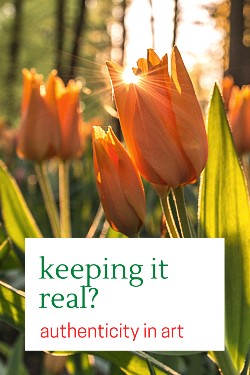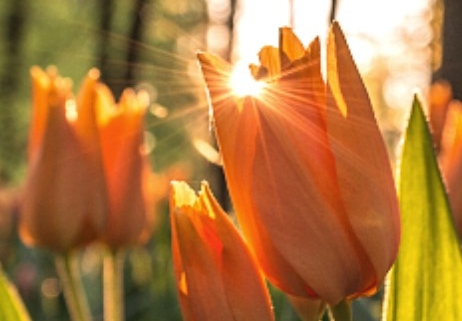Keeping it real? Authenticity and art

We often hear the term ‘authentic’ in everyday usage. Being authentic signals being true to one’s self, to have some degree of courage to put aside outside influences in your art and “just do you”. More broadly, being fake, not being authentically true to one’s self, is a highly charged criticism in today’s world. But where does the idea that we should be authentic come from? What does it mean to be ‘authentic’?
This is something that has been on my mind for a while. After all, in the past, following on from an artistic tradition, rather than being unique and original, was highly valued. Artists studied under masters and learned technique over the course of many years.
Today, we are all encouraged to see ourselves as artists no matter what our level of study or experience. Being self taught, this dilemma is of particular interest to me!
So I wanted to dig a bit deeper on this subject of authenticity in art, as in life.
Back in 2017, when I was really seriously considering giving up the day job to become a professional artist, I attended a fascinating lecture by Dr Tim Black, which I have outlined here. The lecture was titled Who do you think you are? Autonomy, authenticity and the emergence of identity politics. The lecture charted the emergence of ‘authenticity’ as a concept, kicking off the lecture with an Oscar Wilde quote: “‘Know thyself’ was written over the portal of the antique world. Over the portal of the new world, ‘Be thyself’ shall be written.” (From The Soul of Man Under Socialism.)
Individualism is largely associated with the rise of capitalism, yet capitalist society was seen to disenfranchise the individual. We all became alienated cogs in the machine. Because one was not free to be oneself, there was an impetus to reject society and look inwards to explore subjective experience.
Art and the artist became idealised with the emergence of the Romantics, who were concerned with experience of nature. (Simon Schama’s recent BBC series, The Romantics and Us, was very illuminating on how their ideas are still influential today.)
As the ruling class lost legitimacy, there was a sense that society enslaved individuals and to be free meant seeking one’s own validation. Our relationship with nature was a vehicle in which to express one’s true self. Our true selves could be found through the rural landscape, not the alienating city.
Artists were no longer craftsmen following artistic traditions, but seeking originality, and the concept of the ‘creative genius’ emerged. Art for art’s sake, hand in hand with decadence – the stereotype being the absinthe-swilling tortured artist – became fashionable.
The 1920s and 1930s can be seen as a period of high modernism in which exploration of one’s subconscious was validated as opposed to exploration of external reality. For Black, this is epitomised by Virgina Woolfe’s novel To The Lighthouse, in which the denouement is the central character completing her painting. To complete the artwork is completing one’s authentic self.
In art, perhaps the high point of this turn away from reality was in abstract expressionism, which broadly rejected even the merest hint of representation of the outside world in favour of responding to emotional reactions to colour, shape and texture.
By the 1960s, this pursuit of authentic self became politicised. The clarion cry of “the personal is political” encapsulated this. Disillusionment with society meant that the pursuit of the authentic self became mainstream.
In philosophy, this mood was encapsulated in existentialism and in Herbert Marcuse’s notion of ‘one-dimensional man’, seduced but ultimately crushed by industrial capitalism. We saw the rise of therapeutic culture, not only seeking the authentic self but seeking recognition or a mirroring of one’s self in society. Another really interesting book, which provides a fascinating critique of this turn, is Christopher Lasch’s The Culture of Narcissism.
Why is this of interest to me?
As a self-taught artist, I have been trying to wrestle with the question of artistic process. On a very practical level, when I first approached galleries back in 2018, I had more offers than I could supply, which meant that I had to produce high-quality work consistently to keep galleries stocked. Not something I anticipated happening.
Yet I did not want to become set in my style of work, and do similar versions of the same painting over and over. So I became very concerned with finding a process that worked for me and that was, oh yes, authentic!
I wanted to move deeper into abstraction because taking an image as a starting point, even loosely, became too direct an influence for me.
When I say I am largely self taught, I have also been able to pick and choose to learn from artists and I’m indebted to the very generous tutelage of David Graham and Aine Divine.
In the past couple of years, I have taken various courses exploring abstraction with, among others, Alice Sheridan, Emily Ball and Anita Reynolds, all of which I would recommend.
All this time I have been very concerned with finding an authentic process. But the more I consider the concept of authenticity, the less I am concerned with it. It is a mantra that is repeatedly heard but, on reflection, I think it may be unhelpful as a concept. Authenticity seems to imply that there is a fixed ‘me’ to be uncovered. For example, if I produce work that is very different from one week to the next, is one style more ‘authentically me’ than the other, or does it simply reflect that lots of things influence and inspire me?
We do not exist in a bubble, so working ‘intuitively’, it is no surprise that similar visual references pop up in many abstract artists’ work. And I think as long as you are not trying to directly copy, it is okay to allow other artists’ work to influence your own. For instance, I think it can be very useful to reflect on what it is you like about another artists’ work and how you might introduce a new technique into your own work.
So for the time being I am less concerned with the meaning behind my art, and more concerned with enjoying exploring, with little or no intention for the work. That doesn’t mean I won’t reflect on what I am thinking and feeling as I paint. I find regular journaling very helpful to identify what I am finding a pull towards and seeing the threads of ideas coming together.
In that light, I am taking a sabbatical for two months to just follow my instincts on what I find I enjoy painting without any intention of selling the work. I had already intended doing that at the start of the year, but have somehow failed to just paint with no intention. Maybe that reflects another tension for the professional artist: exploring your own interests versus the requirement to produce work to be sold. How can my own reflections on my experience and the world around me strike a chord with others? I can’t simply disappear into my own bubble.
This is the task I have set for myself for the next two months. No consideration of getting work ready for exhibition, but just producing work that excites me.
As for authenticity – well, if I am excited by my work then that will do for me. Let’s see what comes next!



Coming to being this thing I have accepted to be an “artist” by the route I have makes me interested in other folks starting points or priorities – in practice and its development, in conscious study and learning, in developing a cohesive body of work seen to be mature. For me art is expressive or is not art and there must therefore be some personal and unique imperative from which its energy arises. It is only that imperative that has the legs to carry the practice any distance.
I tend to think all art is expressive of something though, it’s a matter of degree.
Plenty artists out there who are doing similar work such as seascapes, and have been at it a very long time, so stamina there but not necessarily anything particularly unique.
Likewise I’m attracted to expressive work but developing craftsmanship/technique doesn’t always lead to that. Think that’s where your unique imperative comes in, what the artist is compelled to paint has to have an energy that allows experimentation.
Your work is a great example of that!